Exploring the Indian Hindu origins of the Balinese Religion
Ganesha, the god with the Elephant head, is an easily-recognised symbol carried over from Indian Hindu origins of the Balinese Hindu religion
Table of Contents Show
The Indian Hindu origins of Bali’s religion
The Balinese religion, known as Agama Hindu or Hindu Dharma, has deep roots in Indian Hinduism. It is important to understand the fundamental philosophy behind Hinduism to grasp the true essence of the Hinduism of the Balinese religion.
Hinduism is founded on the belief that there is order in the world and that the universe operates according to this order.
In this article, we will explore the Indian origins of Balinese religion, exploring the concept of dharma, the role of gods and demons, the significance of karma, and the ultimate goal of moksa.
Hinduism arrived in Indonesia in the 1st-2nd century CE and merged with indigenous animist customs. Hindu deities were worshiped in Indonesian temples, influencing religious and cultural history.
The teachings of honesty, compassion, and Vedic traditions shaped Indonesian culture. This can be seen today in the continued appeal of the Hindu epics Ramayana and Mahabharata which are celebrated through shadow puppets and dance performances in Bali.
The Concept of Dharma
At the core of Hinduism lies the concept of dharma, which is the organizing force that maintains order in the universe. Hinduism recognizes the universe as an interconnected whole, where every person, animal, and thing is an integral part. Each part has a definite and established relationship with every other part, and this relationship is dharma.
Living according to dharma means fulfilling one's duty or order in harmony with the greater whole. A Hindu's actions, or karma, must be in alignment with their dharma to contribute to order and harmony. Failure to do so leads to disorder, chaos, and adharma.
The Equilibrium of Order and Disorder
Black and white check symbolises the balance between order and disorder
Hinduism acknowledges the existence of both order and disorder in the universe. Order is personified as the gods, while disorder is personified as the earth demons. The gods represent positive or good forces, while the demons represent negative or evil forces.
The aim of Hinduism is to maintain an equilibrium or balance between these two opposing forces. This equilibrium ensures the maintenance of order and harmony in the universe. When the disordering force becomes stronger than the ordering force, chaos and suffering prevail. It is essential to keep the ordering force at least as strong as the disordering force to prevent widespread adharma.
Have you noticed the use of black and white in Bali? You will see it on the borders of roads, in the checked cloth draped on shrines, and on the clothing of the ‘Pecalang’ village and temple security staff. This black and white check is a visual representation of the desire for balance, order, and disorder.
Reincarnation and Karma
A fundamental aspect of Hinduism is the belief in reincarnation, known as samsara. According to this belief, the soul or spirit, known as atman, is reborn into another body after death. The specific form of the next incarnation is determined by one's karma, the result of one's actions in previous lives. Karma can be seen as the law of cause and effect, where actions have consequences. Positive actions, aligned with one's dharma, lead to positive outcomes, while negative actions lead to suffering. The goal is to purify one's karma and fulfill one's dharma to break the cycle of samsara and attain moksa, liberation from the cycle of birth and death.
The Pantheon of Hindu Gods
The Balinese gods inspire, instill fear and guide the people in daily life
Hinduism encompasses a vast pantheon of gods and goddesses, each with their own unique characteristics and domains. These deities play a significant role in the religious and spiritual practices of Hindus.
Some of the prominent gods worshiped in Hinduism include:
Indra, the god of storms and war;
Agni, the god of fire;
Rudra, the god of harsh winds;
Sita, the goddess of the plowed field;
Varuna, the god of the earth;
Savitar, the giver of life;
Surya, the god of the sun.
These gods represent different aspects of the natural and spiritual world, and their worship is an integral part of Hindu religious rituals.
The Origins of Hinduism in India
The origins of Hinduism can be traced back to a highly evolved civilization that flourished around 3000 BCE along the banks of the Indus River, in present-day Pakistan. The discovery of the Harappan cities of Harappa and Mohenjodaro revealed a sophisticated society with advanced infrastructure and urban planning. Prior to the Aryan invasion, the indigenous tribes in India practiced an animistic religion, focused on controlling the forces of nature through magical incantations and prayers. The Aryans, a warlike people from Eastern Europe, migrated to northern India and established themselves as rulers, bringing with them their own pantheon of gods and religious practices.
The Aryan Influence on Hinduism
The Aryans introduced the Vedic religion, also known as Vedism, to the Indian subcontinent. The Vedic religion revolved around the worship of nature gods and the performance of religious sacrifices. Indra, Agni, and Surya were among the prominent deities in the early Vedic pantheon.
Over time, the Vedic religion evolved and incorporated elements from the indigenous animistic practices, giving rise to what we now recognize as Hinduism. The Sanskrit language, in which the sacred Hindu texts were written, played a significant role in shaping the religious and philosophical traditions of Hinduism.
The Five Fundamentals of Hindu Philosophy
Hindu philosophy revolves around five key principles, known as the Panca Crada, which form the foundation of Hindu beliefs and practices.
The first principle is Brahman, the one God who encompasses both order and disorder.
Atman, the imperishable spirit, is the second principle and represents the individual soul.
Samsara, the cycle of reincarnation, is the third principle, emphasizing the consequences of one's actions.
Karma-pala, the fourth principle, focuses on the relationship between action and reward or punishment.
The final principle is Moksa, or Moksha, the ultimate goal of Hinduism, which entails liberation from desire and union with God through the pursuit of self-knowledge and liberation.
Balinese Hinduism and the Javanese Majapahit Dynasty
Stories such as the Ramayana are told even today in village ceremonies around the island, a direct connection with the Indian Hindu tradition.
Balinese Hinduism, also known as Agama Hindu or Hindu Dharma, was brought to Bali by the Javanese Majapahit dynasty. Balinese Hinduism is a practical and deeply philosophical religion.
The Balinese people follow the principles of dharma and strive to maintain harmony and order in their lives. They believe that their actions, or karma, should be aligned with their dharma to contribute to the overall equilibrium of the universe. Balinese Hinduism is characterized by vibrant rituals, temple festivals, and a strong sense of community.
-
If you are interested in exploring Balinese Hinduism more deeply, you might like to read the article by Ravinjay Kuckreja. “Balinese Hinduism and Theology.” Academia Letters (2021): n. pag. Web.
This article explores Balinese Hinduism in some depth and the key learnings from the article are as follows:
Summary:
The Balinese religion is a localized form of Hinduism that blended indigenous beliefs, Buddhism, and Hindu philosophy and gods. This blending happened through cultural assimilation over centuries.
Unlike other Hindu traditions, Balinese Hinduism does not follow organized sampradayas (denominations). Instead, it developed its own traditions by combining different philosophies, gods, and rituals.
Old Balinese manuscripts show how the religion fused different characters into one story. For example, five holy men were equated with five Buddhas and later five Hindu gods.
When Indonesia became an independent nation, Balinese religion was not officially recognized. To protect their traditions, the Balinese reorganized their practices into "Agama Hindu Bali" with monotheism and other Abrahamic features required to be an approved religion.
Balinese Hinduism recognizes many Hindu gods but maintains a Shaivite focus on Shiva. The main theological concept is a trinity of three Shivas representing Absolute Reality, Universal Shiva, and the individual soul.
In summary, Balinese Hinduism creatively blended various philosophies and ritual elements into a localized Indonesian version of Hinduism. By officially aligning with Hinduism while restructuring their theology, the Balinese were able to preserve their indigenous religious culture.
More In-depth Summary:
Hinduism is different from Abrahamic religions because its practises and beliefs are not set in stone. Most Hindu practises are based on the Vedas, which are a set of holy texts. The philosophical Upanishads have different ideas about God, what the soul is, how the universe works, and how they all fit together. In India, these beliefs are part of the six traditional schools of Vedic thought, which are called Vedanta, Nyaya, Vaishesika, Yoga, Samkhya, and Mimamsa. These schools bring these traditions together, but some schools say the other one is not orthodox and should not be called that.
In localised Hinduism in Bali, people use their native religion to take in ideas from other places. Balinese Hinduism didn't use the structure of Indian sampradayas, but instead became more organised. The Balinese use the Indonesian word "agama" to talk about religion. This word comes from the Sanskirtagama, which means "that which has come down" and is a legitimate source of knowledge based on authoritative scripture. The Javanese-Balinese set of manuscripts shows how the Balinese agama, which brings together different characters into one story, has changed over time. Ritual texts also talk about these sages, gods, and demons, as well as their other forms and how they relate to the world.
The religion of the Balinese people in Indonesia is a cultural example of openness, but it is not open to everyone. The Pancasila state philosophy says that there is only one God. This means that all officially recognised religions must have a holy book, a prophet, a place of worship, universal beliefs, and other things that are common to Abrahamic faiths. In 1952, the Balinese were called "orang tak beragama," which means "people without a religion." This meant that they could join religions that the government recognised, like Islam, Protestantism, and Catholicism. Hinduism became an official religion in 1958, and the Balinese changed their religion to put more emphasis on the Bible and less on rituals, diversity, uniformity, collective practise, and faith in oneself.
The Balinese religion is based on the Shaivite trinity (Tri-Purusa), which emphasises Shiva's supremacy and His growth. The Trinity is shown by threelingas or in the Mother Temple of Besakih, but these Shivas don't take part in world events directly. The Balinese theology is a metaphysical, vertical classification of the universe, with the state defining, supervising, and moderating everything. This paper looks at the history and theology of Balinese Hinduism. It focuses on how the religion combines different beliefs into its canonical texts and cosmos, like how the five saints, five Shivas, five Buddhas, and the four demons are all one. It also talks about how Hinduism is open to differences and accepts different schools and sects.
The paper also looks at the history of Agama Hindu Dharma in Indonesia, how it was accepted and turned into a religion, and what its theology is. The vertical and horizontal ideas of divinity are used in the Balinese Hindu trinity to bring together the sectarian Shaivite theology and the unifying Hindu trinity. This lets the Balinese keep their own culture and beliefs while making their version of Hinduism more modern.
Conclusion
The Indian roots of Balinese religion are evident in the core principles and philosophies shared with Hinduism. The concept of dharma, the belief in the equilibrium of order and disorder, the significance of karma, and the pursuit of moksa are fundamental aspects of both Hinduism and Balinese Hinduism. Understanding the origins and philosophical underpinnings of Balinese religion allows for a deeper appreciation of its rich cultural heritage. Balinese Hinduism is a testament to the enduring influence of Indian Hinduism and the unique blend of local customs and traditions in the evolution of religious practices.
Fascinated? You might also like to read about: Significant ceremonial days in the Balinese Calendar and The Significance of Holy Water in Balinese Religion
Frequently asked questions about the Indian Hindu origins of the Balinese religion
What is the Indian Hindu influence on Balinese religion?
The Indian Hindu influence on Balinese religion is significant, as it provided the foundation for many of the religious and cultural practices that are still observed in Bali today. Hinduism was brought to Bali by Indian traders and migrants, and it has been adapted to fit the unique cultural and religious context of Bali.
How does the Indian Hindu influence reflect in Balinese religious practices?
The Indian Hindu influence is reflected in Balinese religious practices through the use of Sanskrit language, Hindu deities, and Vedic rituals. Many of the religious ceremonies and rituals in Bali are based on Hindu traditions, although they have been adapted to fit the unique cultural and religious context of Bali.
What is the significance of the Indian Hindu influence in Balinese religion?
The Indian Hindu influence is significant in Balinese religion as it provided the foundation for many of the religious and cultural practices that are still observed in Bali today. It reflects the deep-rooted spiritual beliefs and cultural heritage that are integral to Balinese society.
How does the Indian Hindu influence reflect the Balinese philosophy of Tri Hita Karana?
The Indian Hindu influence reflects the Balinese philosophy of Tri Hita Karana by emphasizing the importance of maintaining balance and harmony between humans, nature, and the divine. Many of the Hindu deities and rituals in Bali are associated with the natural world and are used to seek blessings and protection for the community.
What are some of the Hindu deities that are worshipped in Bali?
Some of the Hindu deities that are worshipped in Bali include Shiva, Vishnu, Brahma, and Ganesha. These deities are associated with different aspects of the natural world and are believed to have the power to bestow blessings and protection on the community.
How does the Indian Hindu influence impact the arts and culture of Bali?
The Indian Hindu influence has had a significant impact on the arts and culture of Bali. Many of the traditional arts, such as dance, music, and theater, are based on Hindu mythology and are used to tell stories and convey spiritual messages. The intricate carvings and sculptures found in temples and other sacred sites also reflect the influence of Indian Hindu art.
How does the Indian Hindu influence shape the religious calendar and festivals in Bali?
The Indian Hindu influence shapes the religious calendar and festivals in Bali by providing the framework for important Hindu festivals and ceremonies. Balinese Hindus celebrate various Hindu festivals such as Galungan, Nyepi, and Saraswati, which are based on the Indian Hindu calendar and traditions.
What is the enduring significance of the Indian Hindu influence in Balinese religion and life today?
The enduring significance of the Indian Hindu influence in Balinese religion and life today is seen in the preservation of ancient rituals, the continued worship of Hindu deities, and the adherence to Hindu philosophical concepts. It serves as a cultural and spiritual anchor, connecting the Balinese people to their ancestral roots and providing a sense of identity and belonging.
How does the Indian Hindu influence contribute to the sense of community and social cohesion in Bali?
The Indian Hindu influence contributes to the sense of community and social cohesion in Bali by providing a shared religious and cultural framework. The participation in Hindu rituals and ceremonies fosters a sense of unity and belonging among the Balinese people, reinforcing social bonds and promoting a collective identity.
How has the Indian Hindu influence evolved and adapted in Bali over time?
The Indian Hindu influence has evolved and adapted in Bali over time to incorporate local beliefs, customs, and traditions. It has assimilated with indigenous Balinese animism and ancestor worship, resulting in a unique blend of Hindu-Balinese practices. This adaptation has allowed the religion to thrive and remain relevant in Balinese society today.























Bali's remarkable rice terraces draw numerous tourists. However, could tourism pose a threat that the age-old Subak system might struggle to overcome?